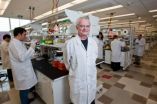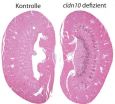(Press-News.org) Scientists have pinpointed a gene that enables rice plants to produce around 20% more grain by increasing uptake of phosphorus, an important, but limited, plant nutrient.
The discovery unlocks the potential to improve the food security of rice farmers with the lowest value phosphorus-deficient land allowing them to grow more rice to add to global production, and earn more.
The gene – called PSTOL1 which stands for Phosphorus Starvation Tolerance – helps rice grow a larger, better root system and thereby access more phosphorus. Farmers can apply phosphorus fertilizers to increase productivity but on problem soils phosphorus is often locked in the soil and unavailable to plants.
Also, phosphorus fertilizer is often unaffordable to poor farmers. Adding to the problem is that phosphorus is a non-renewable natural resource and rock phosphate reserves – the source of most phosphorus fertilizers – are running out.
"For many years we have searched for genes that improve phosphorus uptake," said Dr. Sigrid Heuer, senior scientist at the International Rice Research Institute (IRRI) and leader of the team that published the discovery in Nature.
"We've known for a long time that the traditional rice variety Kasalath from India has a set of genes that helps rice grow well in soils low in phosphorus," she added.
Kasalath's superior performance under phosphorus deficiency was initially discovered by Dr. Matthias Wissuwa from the Japan International Research Center for Agricultural Sciences. He then started collaborating with IRRI and shared the DNA information of Kasalath. The current research was supported and facilitated by the CGIAR Generation Challenge Program.
"We have now hit the jackpot and found PSTOL1, the major gene responsible for improved phosphorus uptake and understand how it works," Heuer said.
According to Dr. Wricha Tyagi at the School of Crop Improvement at the Central Agricultural University in the Indian state of Meghalaya, knowledge of the exact gene will be critical for future breeding programs suited to Eastern and North-Eastern – parts of India where rice productivity is less than 40% of the national average due to acidic soil and poor availability of phosphorus.
The discovery of the PSTOL1 gene means that rice breeders will be able to breed new rice varieties faster and more easily, and with 100% certainty their new rice will have the gene.
Dr. Joko Prasetiyono, of the Institute for Agricultural Biotechnology and Genetic Resources Research and Development in Indonesia, is breeding rice plants with the PSTOL1 gene. The plants are not genetically modified just bred using smart modern breeding techniques.
"In field tests in Indonesia and the Philippines, rice with the PSTOL1 gene produced about 20% more grain than rice without the gene," said Heuer.
"In our pot experiments," she added, "when we use soil that is really low in phosphorus, we see yield increases of 60% and more, suggesting it will be very effective in soils low in phosphorus such as in upland rice fields that are not irrigated and where farmers are often very poor."
The PSTOL1 gene is also being tested in rice varieties for the more productive irrigated rice-growing areas and initial results show that the plants grow a better root system and have higher production too. This means it could help farmers in these areas reduce their fertilizer use and expenditure without compromising productivity.
The discovery also demonstrates the importance of conserving the genetic diversity of traditional crop varieties such as Kasalath. IRRI conserves more than 114,000 different types of rice in the International Rice Genebank.
The group of rice (the aus-type) that Kasalath is part of is also the source of the submergence tolerance gene, which IRRI has used to breed submergence-tolerant (Sub1) rice varieties that are being widely adopted across Asia.
New rice varieties with the enhanced capacity to take up phosphorus may be available within a few years to farmers.
### This research has been conducted in collaboration with JIRCAS, the University of Milano in Italy, the University of the Philippines Los Baños, and the Institute for Agricultural Biotechnology and Genetic Resources Research and Development in Indonesia. The main financial support was provided by the CGIAR Generation Challenge Program, with supplementary funding from other donors.
Underground solution to starving rice plants
2012-08-23
ELSE PRESS RELEASES FROM THIS DATE:
The Milky Way now has a twin (or 2)
2012-08-23
Research presented today at the International Astronomical Union General Assembly in Beijing has found the first group of galaxies that is just like ours, a rare sight in the local Universe.
The Milky Way is a fairly typical galaxy on its own, but when paired with its close neighbours - the Magellanic Clouds - it is very rare, and could have been one of a kind, until a survey of our local Universe found another two examples just like us.
Astronomer Dr Aaron Robotham, jointly from the University of Western Australia node of the International Centre for Radio Astronomy ...
New insights into why humans are more susceptible to cancer and other diseases
2012-08-23
Chimpanzees rarely get cancer, or a variety of other diseases that commonly arise in humans, but their genomic DNA sequence is nearly identical to ours. So, what's their secret? Researchers reporting in the September issue of the American Journal of Human Genetics, a Cell Press journal, have found that differences in certain DNA modifications, called methylation, might play a role.
The researchers discovered hundreds of genes that display different patterns of methylation between the two species. These different patterns of methylation lead to different levels of expression, ...
'Naked Darth Vader' approach could tame antibiotic resistant superbugs
2012-08-23
Rather than trying to kill bacteria outright with drugs, Université de Montréal researchers have discovered a way to disarm bacteria that may allow the body's own defense mechanisms to destroy them. "To understand this strategy one could imagine harmful bacteria being like Darth Vader, and the anti-virulence drug would take away his armor and lightsaber," explained Dr. Christian Baron, the study's lead author and Professor at the Department of Biochemistry. "A naked Darth Vader would be an easy target and similarly, pathogenic bacteria without their virulence factors would ...
Histone-modifying proteins, not histones, remain associated with DNA through replication
2012-08-23
PHILADELPHIA—It's widely accepted that molecular mechanisms mediating epigenetics include DNA methylation and histone modifications, but a team from Thomas Jefferson University has evidence to the contrary regarding the role of histone modifications.
A study of Drosophila embryos from Jefferson's Department of Biochemistry and Molecular Biology published ahead of print in Cell August 23 found that parental methylated histones are not transferred to daughter DNA. Rather, after DNA replication, new nucleosomes are assembled from newly synthesized unmodified histones.
"Essentially, ...
Study reveals human drive for fair play
2012-08-23
People will reject an offer of water, even when they are severely thirsty, if they perceive the offer to be unfair, according to a new study funded by the Wellcome Trust. The findings have important implications for understanding how humans make decisions that must balance fairness and self-interest.
It's been known for some time that when humans bargain for money they have a tendency to reject unfair offers, preferring to let both parties walk away with nothing rather than accept a low offer in the knowledge that their counterpart is taking home more cash.
In contrast, ...
Therapeutic avenues for Parkinson's investigated at UH
2012-08-23
HOUSTON, Aug. 23, 2012 – Scientists at the University of Houston (UH) have discovered what may possibly be a key ingredient in the fight against Parkinson's disease.
Affecting more than 500,000 people in the U.S., Parkinson's disease is a degenerative disorder of the central nervous system marked by a loss of certain nerve cells in the brain, causing a lack of dopamine. These dopamine-producing neurons are in a section of the midbrain that regulates body control and movement. In a study recently published in the Proceedings of the National Academy of Sciences (PNAS), ...
Gene 'switch' may explain DiGeorge syndrome severity
2012-08-23
The discovery of a 'switch' that modifies a gene known to be essential for normal heart development could explain variations in the severity of birth defects in children with DiGeorge syndrome.
Researchers from the Walter and Eliza Hall Institute made the discovery while investigating foetal development in an animal model of DiGeorge syndrome. DiGeorge syndrome affects approximately one in 4000 babies.
Dr Anne Voss and Dr Tim Thomas led the study, with colleagues from the institute's Development and Cancer division, published today in the journal Developmental Cell.
Dr ...
New insights into salt transport in the kidney
2012-08-23
Sodium chloride, better known as salt, is vital for the organism, and the kidneys play a crucial role in the regulation of sodium balance. However, the underlying mechanisms of sodium balance are not yet completely understood. Researchers of the Max Delbrück Center for Molecular Medicine (MDC) Berlin-Buch, Charité – Universitätsmedizin Berlin and the University of Kiel have now deciphered the function of a gene in the kidney and have thus gained new insights into this complex regulation process (PNAS Early Edition, doi/10.1073/pnas.1203834109)*.
In humans, the kidneys ...
Cloud control could tame hurricanes, study shows
2012-08-23
They are one of the most destructive forces of nature on Earth, but now environmental scientists are working to tame the hurricane. In a paper, published in Atmospheric Science Letters, the authors propose using cloud seeding to decrease sea surface temperatures where hurricanes form. Theoretically, the team claims the technique could reduce hurricane intensity by a category.
The team focused on the relationship between sea surface temperature and the energy associated with the destructive potential of hurricanes. Rather than seeding storm clouds or hurricanes directly, ...
Canadian researcher is on a mission to create an equal playing field at the Paralympic Games
2012-08-23
Vancouver, BC – August 23, 2012 – Vancouver-based clinician and researcher Dr. Andrei Krassioukov is packing for the upcoming Paralympic games in London. Rather than packing sports equipment, he has a suitcase full of advanced scientific equipment funded by the Canada Foundation for Innovation that he will use to monitor the cardiovascular function of athletes with spinal cord injuries.
Up to 90% of people with injuries between that cervical and high thoracic vertebrae suffer from a condition that limits their ability to regulate heart rate and blood pressure. For top-level ...

